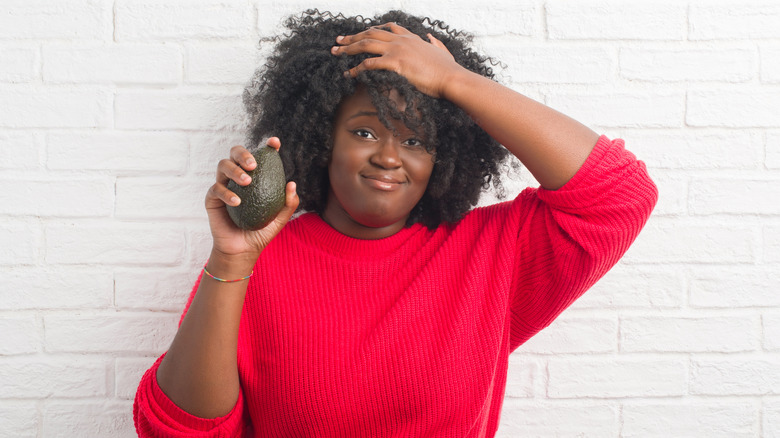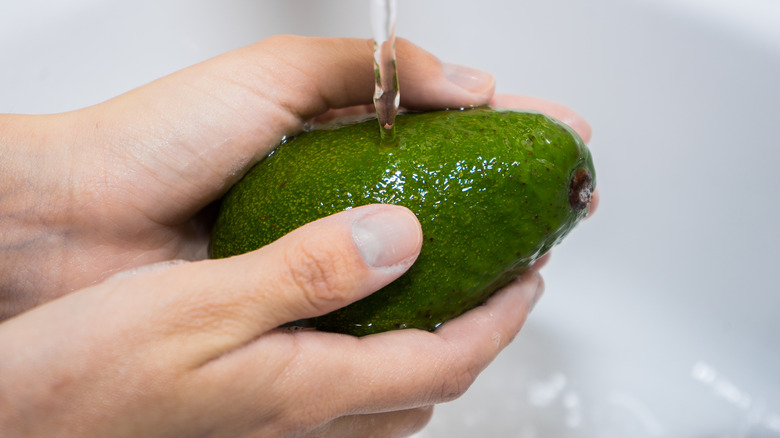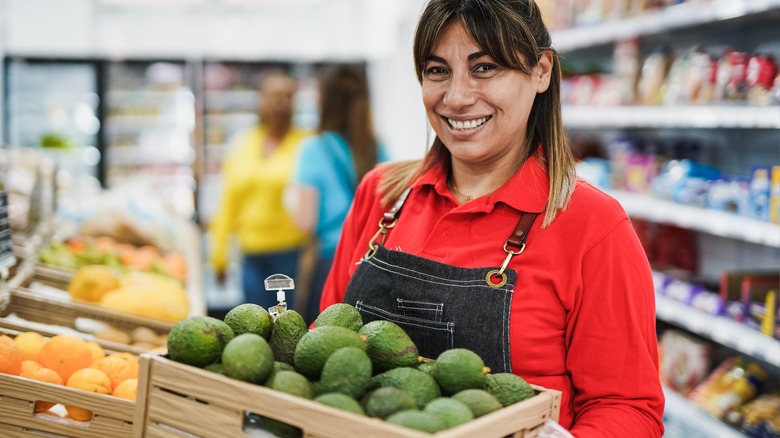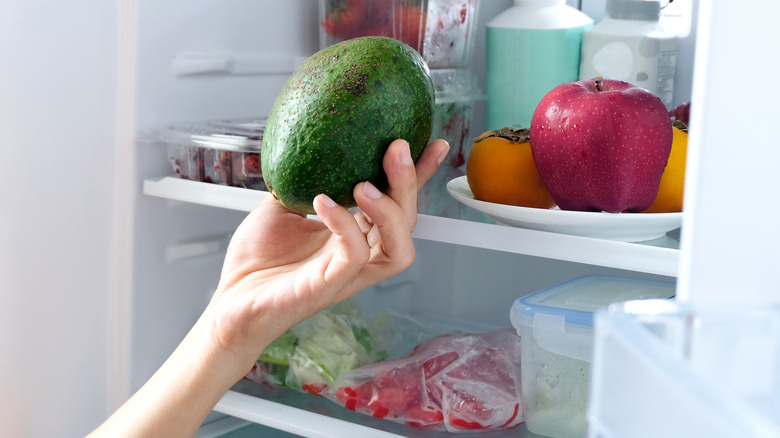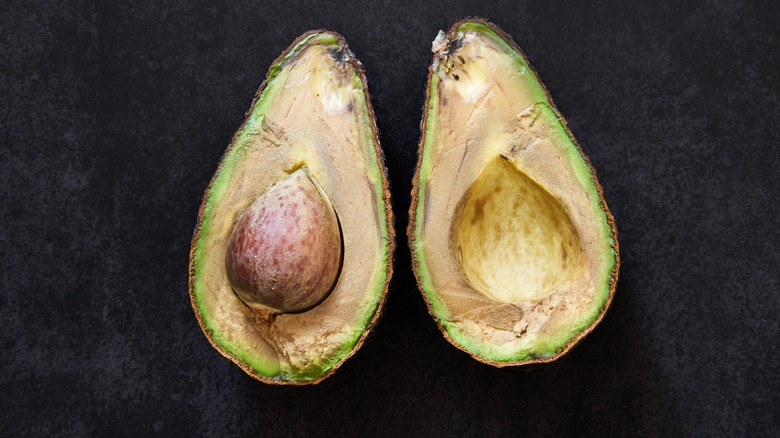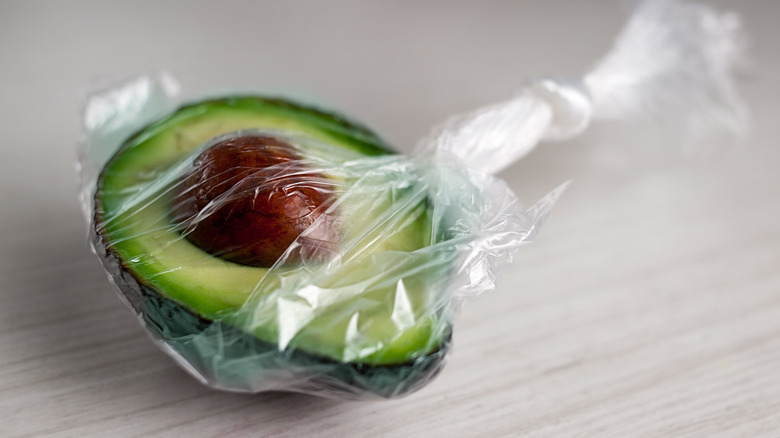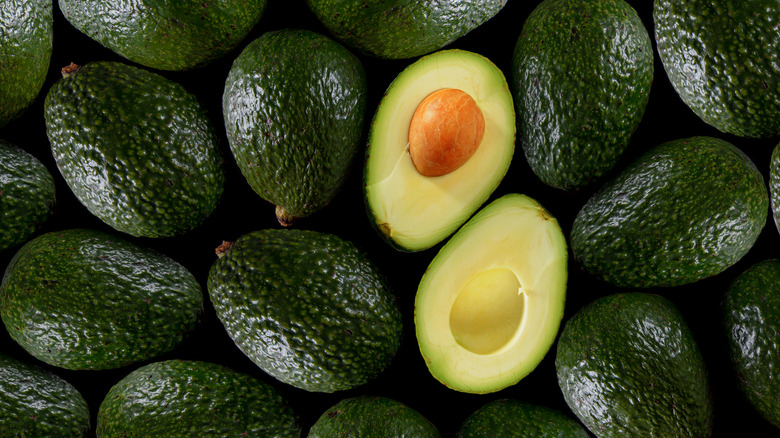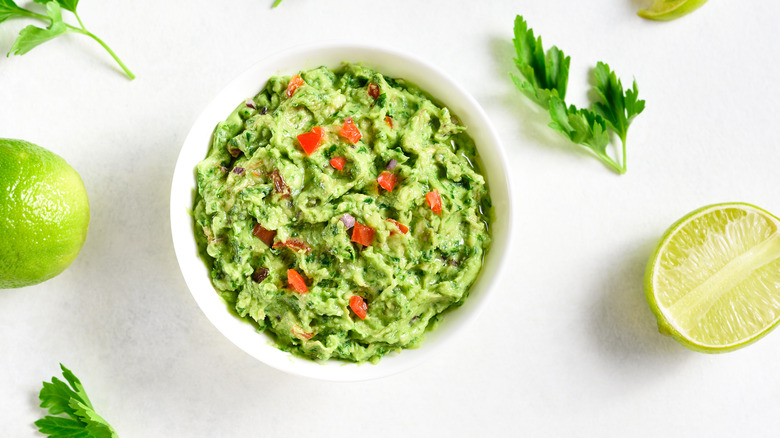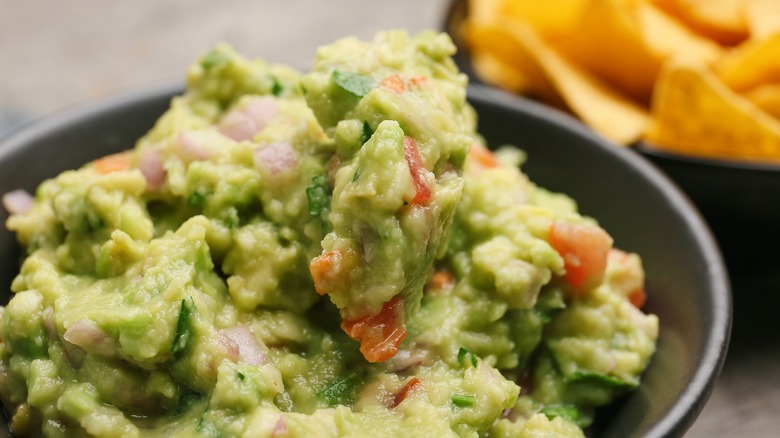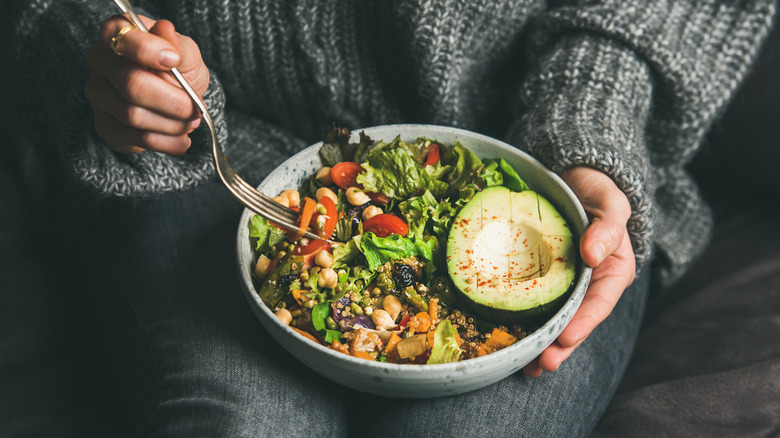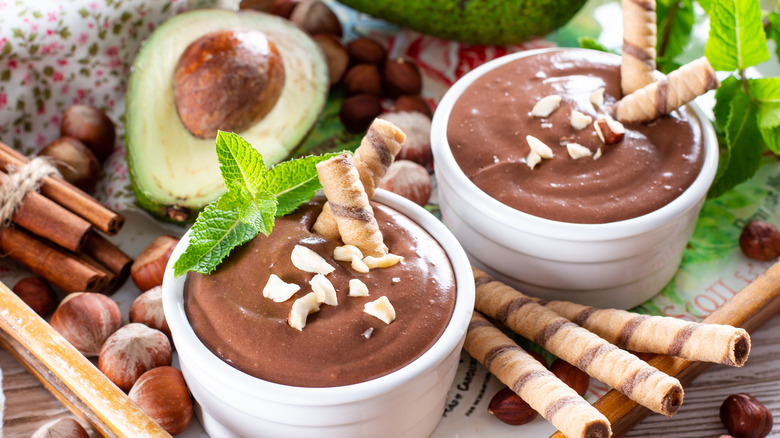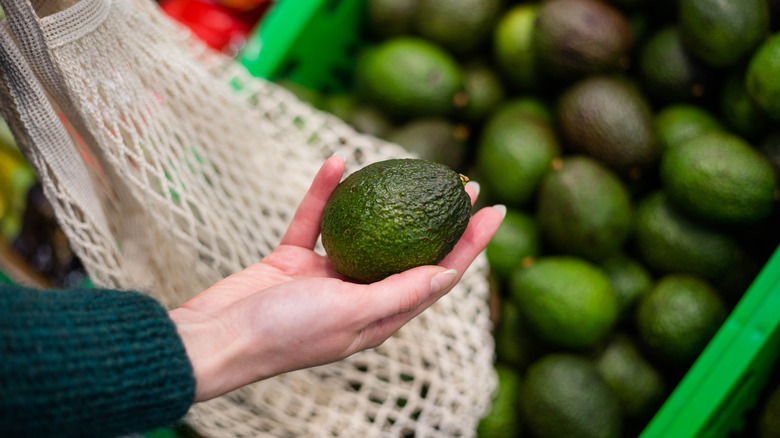14 Mistakes You Need To Avoid With Avocado
We think it's fair to say that avocados are pretty popular. The fleshy fruit has been a staple in diets across the globe — in the United States, avocado popularity is relatively recent, with Rudolph Hass being largely responsible for the cultivation of avocados in America through his development of the Hass variety during the 20th century (per Tasting Table).
Nowadays, avocados are pretty much everywhere you look, from chunks sitting in salads to mashed avocados filling up bowls of guacamole — and in 2020, approximately 2.7 billion pounds of the fruit were eaten by Americans, according to Statista. That's a lot of avo toast!
But, while avocados are more popular than ever, they can also be surprisingly tricky. We've all had the misfortune of coming home with a rock-hard avocado that hasn't ripened yet, or sliced one open only to find that it's gone completely brown mere hours later. What gives? And how can we perfect our avocado game so that we make sure we're enjoying them every time? Well, read on to discover all the ways to avoid common mistakes with avocados.
Not waiting until your avocado is ripe
This is something pretty much everyone who buys avocados has experienced: Throwing a few of the fruits into your basket, but when you get home, either they aren't ripe or way too ripe and have gone brown. Then, if you're anything like us, you've tried to use the avocado in a recipe. Unfortunately, this is one of the biggest mistakes you can make with avocados. While they're safe to eat when raw, the fact is that they just won't taste very good. And not only that, but unripe avocados are often pretty tough and don't have that creamy texture we know and love.
Instead, if you're not willing to wait for it to ripen at home, the best thing to do is to make sure the avocados you're buying are ripe to begin with. "A really good trick to find out whether an avocado is ripe is to look at the cap that forms where it would meet the stem of the tree," recommends chef Cher Loh, Good Housekeeping Institute Cookery School (via Good Housekeeping). If you try and take off the cap and it's not budging or is hard to peel off, then it's not ripe enough. If the cap comes off easily and the flesh underneath is green, then you should be good to go.
Forgetting to wash your avocado
Okay, hands up if you've done this one. All of us? That's what we thought. We can understand how this common mistake can be made, though. You don't eat the skin of the avocado and only consume what's inside, so why would you wash it the same way that you would other fruit or vegetables?
Well, as it turns out, there's good reason to wash an avocado. Avocados may contain germs or bacteria on their outsides — especially if they've been sitting in the supermarket for a while, being touched by numerous people — and when you slice them open and prepare them, these germs can move from the outside of the fruit to the part you're about to eat, according to the Centers for Disease Control and Prevention.
Instead, a quick clean of your avocados can reduce the risk of cross-contamination. Using a vegetable brush while holding your avocado under running water can help you get into the nooks and crannies of the skin. Make sure you're only washing with regular water — avoid using soap, detergents, disinfectant products, or bleach-based solutions.
Buying loads of avocados at once
If you're the kind of person who likes to bulk-buy their produce, you might be applying the same rule to avocados, especially if you eat a lot of them. But while this might make sense on a time-saving level — or if you're trying to grab yourself a multi-buy deal — this practice may lead to you losing money, and wasting food along the way.
When you buy avocados in bulk, you're usually buying a lot of fruits that were cultivated at the same time, and which will likely all be as ripe as each other (per Mashed). Unless you're planning on eating them all within the limited period a ripe avocado remains fresh — usually three to four days on the shelf, and slightly longer in the fridge, according to EatByDate – you could end up with rotten avocados that you have to throw away. We recommend you only buy as many avocados as you know you'll consume. It might mean another trip to the store, but that'll be preferable to trying to eat a gone-off avocado.
Putting them in the refrigerator too quickly
It makes sense that you'd want to transfer your avocados to the fridge as soon as you get home. After all, the fridge keeps things fresh for longer, so why wouldn't you want your avocados to last a little extra time? The reason is due to the ripening process that avocados undergo. If you put them in the fridge before they're ripe, you may be in for a pretty long wait for them to become fresh (via The Daily Meal).
Instead, leave them out of the fridge at room temperature, to allow the avocado to ripen at its own speed. You can also place them in a paper bag alongside a banana or an apple to speed up the process, as the ethylene gases that these fruits release will cause the avocado to ripen even quicker (per Love One Today). Once your avocado is ready to eat, you can then place it in the fridge, where you should get a few extra days out of it, explains Avocados from Mexico.
Mistaking a brown avocado for a rotten one
So, you've cut your avocado in half, and it's looking a little brown at certain points. A bit strange, you think, but hey, you've eaten an avo before that had brown bits after slicing it open, so what's the worst that can happen, right?
Unfortunately, this is a mistake that could turn your avocado-based meal sour pretty fast. A little browning on the surface of an opened avocado is a result of the natural oxidation process that occurs when the flesh comes into contact with air, explains Savannah Braden, biological scientist and Apeel Sciences associate director of technology, via Forbes. While this may not look very good, it's totally safe to eat, as Tasting Table states.
However, if you notice dark spots or streaks on the flesh when you cut into an avocado, it's likely that it's already gone off, says Healthline. Luckily, parts of the avocado may still be salvageable, especially if browning is isolated or caused by the fruit being bruised — but it's best not to eat any spoiled parts, as they're not gonna taste great. If your avocado has a particularly bad smell or is growing mold, you should throw away the whole thing, to avoid contracting an illness from eating it.
Storing them incorrectly once open
For a lot of people, half of an avocado is pretty much the ideal amount to put in salads or on toast. But once you've sliced it in half, there's the small matter of how to store the fruit, and improper storage of avocado can lead to browning, notes Healthline.
That's why it's important to master how you store your avocados once they're open. The best way to do this is with plastic wrap. Lay the plastic wrap on a clean surface, and place the sliced avocado on it, flesh-side down. Then, wrap up the avocado, making sure there's no air trapped inside the plastic, and then place the whole thing in a zip-lock bag. This should keep your fruit fresh, with minimal browning, that you can then scrape off before you eat it. Squeezing a few drops of lemon juice over the flesh of the avocado before you wrap it up could also prevent browning — the acidity of the juice will bring down the pH level of the fruit, stopping the enzymes that produce browning from working as effectively.
Taking out the pit wrong
How badly can you mess up taking the pit out of an avocado? As it turns out, pretty darn badly. Knife injuries that occur as a result of preparing an avocado are common, potentially thanks to the increase in the avocado's popularity, states a study published in The American Journal of Emergency Medicine. A large proportion of these injuries could be because of the way people remove the pit, which often involves using a knife to slam into the pit (and then, well, hitting your hand instead), says hand surgeon Ramsey Ellis (via OSF HealthCare).
So, save your fingers — use a spoon. Grab a smaller-sized spoon, and then slide the tip of it under the pit of the avocado, on its narrowest side, explains Tasting Table. Then, use the leverage on the spoon to pry it out. The pit should come out relatively easily, leaving you with nothing but the fruit, and your hands still intact. Alternatively, if you don't have a spoon, try applying pressure with your thumb on the back of the avocado, while securing it with your hand on the other side, to pop the pit out.
Trying to juice your avocado
As a fruit chock-full of vitamins, minerals, and healthy fats, it makes sense that you'd want to include it in a healthy morning juice (per Medical News Today). But before you toss it in the juicer with your spinach and carrots, we'd recommend you pause. Unfortunately, avocados simply don't have a texture that lends itself to juicing, as the fleshy fruit, similar to bananas, tends to just mush up when pressed (via The Daily Meal). This can lead to a lot of gunk in your juicer, and pretty unsatisfying juice.
That doesn't mean avocados can't be used in any liquid form, though. They're a natural choice to put into a smoothie, and blending one alongside a frozen banana and some milk can create a nutritious morning beverage (per Mashed). Avocado oil can also be extracted by blending, cooking, and then straining avocados through a cheesecloth, AvoSeedo explains. You might find it a little easier to just buy a bottle in the store, however.
Waiting until they're ripe
Okay, so we can see how you might not think this is a mistake. After all, unripe avocados aren't that enjoyable, so why wouldn't you wait for them to ripen before eating them? Well, the mistake lies not so much in the fact that your avocados should be ripe, but that you're watching the clock for days on end, waiting for them to be ready. Mashed explains that you can bring avocados to full ripeness in virtually no time at all using an oven.
Set the oven to 200 degrees Fahrenheit and while you're waiting for it to come up to temperature, place your unripe avocado in tin foil, wrapping it tightly. By wrapping it in foil, the avocado will ripen throughout. Then, pop the avocado in the oven. You should allow it to sit in there for around 10 minutes — then remove it (it's best to use an oven glove or tongs to do this), and set it aside to come back down to room temperature. Once it's cooled, slice open the avocado: It should be perfectly ripe. Pretty neat, huh?
Seasoning your avocado incorrectly
A bowl of guacamole with a side of chips for dipping is — for many people — the perfect snack. But if that guacamole's seasoning balance is off, that bowl can quickly go from tasty to terrible. Avocados have a fairly subtle flavor and without the right seasonings, the fruits and foods they comprise can quickly become bland, as World's Garden discusses. That's why it's important to put a good amount of salt in guacamole, to bring the avocado and the other fruits in the dip to life. And make sure you taste it before serving.
While under-seasoning your avocados can leave them wanting more, adding too much seasoning can quickly create a meal that's less than pleasant to eat. This is not just a problem with salt, which can make your guacamole unappetizing, but with lemon juice as well. While a squeeze of lemon juice gives a hint of acidity that will balance the creamy flavor of avocado (and help stop the avocado from browning), adding too much will leave you with bitter-tasting food. Remember, always add a little at a time, and taste continuously, to nail your seasoning balance.
Over-mashing your avocados
To get the perfect guacamole, it's all about consistency. But it's easy to take things a little too far. While it's important to make sure your avocado is mashed enough in any dip you're serving up, mashing it too much can leave you with super-smooth guacamole with no chunks whatsoever — and those chunks are vital for a satisfying guac, urges World's Garden.
Avoid the temptation of the food processor to make guacamole, as you'll end up with an avocado puree instead of the hearty dip you desire. The best thing to do is use a fork. Simply press down on the avocados with the back of the fork, until you get a good balance of lumps and smooth avocado. If you want to have a slightly smoother dip while still retaining smaller chunks, a potato masher can also be used (via Mashed). Ensure you're not dawdling while you're mashing, as the oxidization that starts to occur once an avocado is exposed to the air may result in it turning brown.
Eating too many avocados
Look, we get it: Avocados are tasty. We understand why you'd want to make them a core component of your diet, and it's certainly true that doing so can amp up not only your tastebuds but the nutrition of your food as well. Avocados are loaded with healthy omega-3 fats and an abundance of fiber, "which is important for feeling full between meals and for keeping our digestive tract moving and lowering our cholesterol," says Ariana Cucuzza, registered dietitian (via the Cleveland Clinic). Additionally, avocados are a great source of the mineral potassium, which keeps your muscles and heart in check.
However, all of these nutritional bonuses might lead people to eat avocados to excess — and this can become a problem. As Cucuzza states, the over-reliance on avocados as a fat source can mean you're omitting other things from your diet, leading to a lack of dietary diversity, which rarely ends well. Additionally, although avocados are a healthy source of fats, there's no denying they're higher in calories than a lot of other fruits, which may be less desirable for individuals looking to reduce calorie intake. That's why Cucuzza recommends eating between one-half to a whole avocado per day.
Assuming avocados are only for savory dishes
Most people are familiar with avocados being used in a savory context, from guacamole to chunks of avocado thrown into a lunchtime salad, to slices topping a fiery chili. But you're missing a trick if you're not utilizing your avocados in sweet dishes too. It makes perfect sense: Avocados have an unrivaled creaminess that makes them an excellent ingredient in desserts and sweet treats, according to Mashed. Additionally, avocados have a versatile and unintrusive flavor, meaning that they can add texture to a dish without overpowering it.
For a quick and healthy dessert, try an avocado chocolate pudding. All you have to do is take a few avocados, a banana, vanilla extract, and a 1/2 cup each of soaked dates and unsweetened cocoa powder, and throw them into a food processor. Blitz until there are no lumps left, spoon it into your serving dishes, and cool it down in the refrigerator before feeding it to your grateful guests.
Opting for the same avocado again and again
A lot of us are creatures of habit, and we stick to what we know. This can translate into our shopping routines, with many people choosing to grab the same avocados in the grocery store week in and week out. By doing so, you're missing out on a world of variety — and while you might assume that avocados are all the same, you'd be mistaken.
Take the Tonnage avocado, for example. This variant of the fruit has an especially sweet tone to its flesh, which makes it particularly well-suited to use in desserts or sweeter dishes compared to other types (via Food Republic). Avocados can also vary in fat content, with Florida avocados generally being less oily than the ever-popular Hass variety, and may be preferable to people who prefer a slightly lighter fruit. Certain strains of avocado may also be better suited to the circumstances you're buying them for.
If you're dining solo and want to cut down on waste, Shepard or Mexicola Grande avocados may be your best bet for their smaller size. If you're looking to make a jumbo guac, on the other hand, a larger variety like the Daily 11 or Anaheim may be more your speed. The possibilities are endless!
